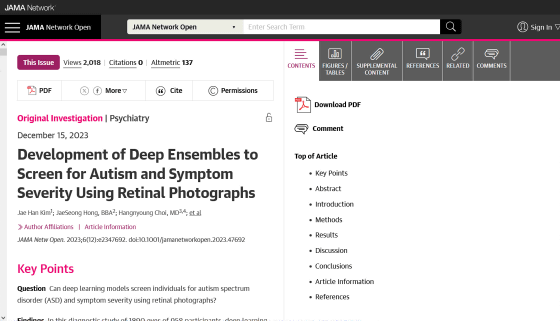Research results show that AI model can 100% tell whether a child is autistic just by looking at ``photos of the retina''

A research team at Yonsei University School of Medicine in South Korea has developed a deep learning AI model that can identify children with autism spectrum disorder (ASD) , who have characteristics such as communication and behavior, with 100% accuracy just by looking at retinal photographs. Did. It is expected that AI may become a promising option as an objective screening tool for early diagnosis of children with ASD.
Development of Deep Ensembles to Screen for Autism and Symptom Severity Using Retinal Photographs | Ophthalmic Imaging | JAMA Network Open | JAMA Network
https://jamanetwork.com/journals/jamanetworkopen/fullarticle/2812964

AI-screened eye pics diagnose childhood autism with 100% accuracy
https://newatlas.com/medical/retinal-photograph-ai-deep-learning-algorithm-diagnose-child-autism/
A Hidden Pattern in Children's Eyes Can Reveal if They Have Autism : ScienceAlert
https://www.sciencealert.com/a-hidden-pattern-in-childrens-eyes-can-reveal-if-they-have-autism
The retina inside the eyeball is lined with more than 100 million photoreceptor cells that detect light, and the information detected by the photoreceptor cells is sent to the brain via the optic nerve. The optic nerves that extend throughout the retina form a thick bundle of more than 1 million nerves at the back of the eyeball, and penetrate the wall of the eyeball at a single point called the optic disc .
The optic disc is a 'window to the brain' that is an extension of the central nervous system, and in recent years, attempts have been made to obtain brain-related information by easily and non-invasively accessing the optic disc. A British research team has already devised a method to detect traumatic concussions by irradiating the retina with a laser.
A new research team at Yonsei University School of Medicine has developed a deep learning AI model that screens children's 'retinal photographs' to diagnose whether they have ASD and the severity of ASD. 'People with ASD have structural changes in the retina that may reflect changes in the brain, including abnormalities in visual pathways through embryonic and anatomical connections,' the research team said. states.

First, the research team trained an AI model on retinal photographs that correlated the presence or absence of ASD and the severity of ASD. The severity of ASD was evaluated by the scores of the Autism Diagnostic Observational Test, 2nd edition (ADOS-2) and the Social Responsiveness Scale, 2nd edition (SRS-2).
Using a total of 1,890 retinal photographs collected from 958 children with an average age of 7.8 years, we tested whether the AI model could accurately measure the presence and severity of ASD. Approximately half of the participants had been diagnosed with ASD, and the remaining half were age- and gender-matched non-ASD controls.
As a result of testing, the AI model was able to determine with 100% accuracy whether a child has ASD based on a photo of the retina. There was also no noticeable decrease in accuracy when only 10% of the photos containing the optic disc, which may be important for diagnosing ASD, were kept and the rest removed. This indicates that the optic disc is an important region to distinguish between ASD and neurotypical development.
On the other hand, in a test that used retinal photographs to predict the severity of ASD, the accuracy of predicting severity based on ADOS-2 was 66%, and the accuracy of predicting severity based on SRS-2 was only 48%. The research team says, 'We found that a feasible severity classification was only possible with the ADOS-2 score and not with the SRS-2 score. This is because the ADOS-2 This may be because the SRS-2 is typically assessed by caregivers over a period of several minutes, whereas the SRS-2 is assessed over a sufficient period of time by a trained professional.Thus, the former provides a more accurate assessment of severity than the latter. 'The AI model also showed promise in measuring severity,' he said.

Since the minimum age of the subjects in this study was 4 years old, the research team claims that the AI model can be used as an objective screening tool for ASD in older age groups. On the other hand, since a newborn's retina continues to grow until the age of 4, further research is needed to confirm whether the AI model functions accurately even in children under 4 years old.
The research team said, ``Although further research is needed to establish generalizability , this study is a notable step toward developing an objective screening tool for ASD. It will help address urgent issues such as 'people who are unable to access child psychiatry specialists because of their health problems'.'
Related Posts:
in Science, Posted by log1h_ik







